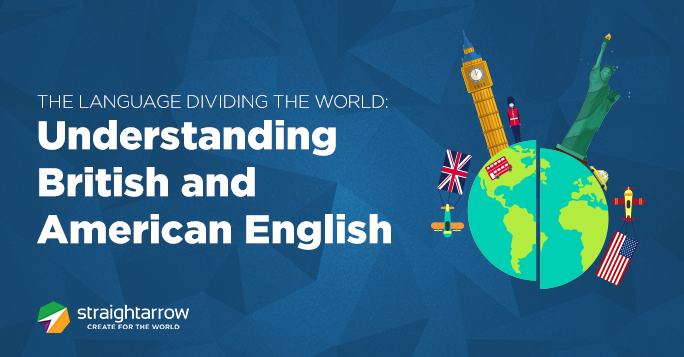
Oscar Wilde, a famed writer from London, once said that his homeland had “everything in common with America… except, of course, the language.” Just as speakers of Mandarin and Cantonese know that the broad label of “Chinese” doesn’t reflect their dialects’ differences, users of English are often flummoxed by how different their language seems on the other side of the Atlantic.
There are two general kinds of English prevalent in the world today: American English, which developed in the United States of America; and British English, which has its roots in the United Kingdom. Other English speaking countries introduce quirks of their own when they adopt the language, but for the most part follow one of these two traditions.
It would be a tremendous undertaking to identify all the differences between American and British English, but even an understanding of basic differences goes a long way. Familiarise yourself with some ways the two differ in spelling, grammar and vocabulary, and you’ll have yourself a steady foundation for learning the rest as you go—for as with all matters in language, there’s no substitute for practice and immersion.
Spelling
One of the most apparent differences between the American and British kinds of English is the way things are spelled. Fortunately, most of these differences fall under a few rules of thumb. Below are some of the general rules for converting between British English and American English spelling conventions. The British English spelling is listed before the American English.equivalent
- –our and –or, as in “colour” and “color”
This rule extends to most words that, in British English, end in unstressed –our syllables. Other examples would be flavour/flavor, humour/humor and behaviour/behavior.
- –re and –er, as in “centre” and “center”
This is common in words that end in –tre and –bre; conversely, -ter and -ber. Other examples are fibre/fiber, metre/meter and litre/liter.
Note that while the word theatre/theater fits in this rule, both spellings are acceptable in American English. Words ending in the suffix -er, meaning something or someone that serves a particular function, are also exempt.
- –ise/-yse and –ize/-yze, as in “analyse” and “analyze”
This rule works with words that use this suffix, as well as words that derive from it. Thus, realise would, in American English, be spelled as realize. Similarly, realisation would become realization.
- –ogue and –og, as in “dialogue” and “dialog”
Also seen in words like catalogue/catalog, monologue/monolog. It should be noted that the –ogue spelling of certain words is accepted in American English, though less common.
- ae/oe and e, as in “foetus” and “fetus”
The distinction here arose from a pair of glyphs that have fallen out of widespread use in English in general, æ and œ. Some other examples are mediaeval/medieval and paediatrician/pediatrician. Exceptions to this are aesthetics and archaeology, which are commonly spelled that way in American English, too.
- ll and l, as in “installment” and “instalment”
In a number of cases, American English omits the second l in cases of doubles. Examples include traveller/traveler and enrollment/enrolment. A curious exception is the case of fulfil, which is more often spelled with a double l in American English, and a single l in British English.
Grammar
- Collective Nouns
Where collective nouns are concerned, verb agreement is more flexible in British English. Collective nouns are treated as singular or plural depending on the context. Where the emphasis is on the collective noun as a unified body, singular verbs are used; but where the emphasis is on individual members, plural verbs are used. Take the collective noun “team” as an example. You could say “The team have donned their uniforms.” The emphasis here is on the team’s individual members, as each would have separate garments. On the other hand, you might say “The team has taken the championship.” In this case, because the team competed as a single entity, the verb employed is singular.
In American English, on the other hand, the collective nouns are almost always treated as singular. Only in cases where the intent is to emphasize a lack of unity in action is the plural form used.
- Verbs
There are quite a few differences here, but the most common ones come up in the way verbs are written in the past tense and past participle. In certain verbs, like dream, leap, burn and spoil, the past tense may take the regular form, as in dreamed, leaped, burned and spoiled, or the irregular form, as in dreamt, leapt, burnt and spoilt. Both regular and irregular forms are common in British English, but irregular forms are uncommon for most words in American English.
Vocabulary
While some general rules can be drawn up for cases of spelling and grammar, there aren’t really any shortcuts when it comes to learning discrepancies in vocabulary. That said, it may be useful to note that these differences arise because of two basic components in the way we define things: words themselves, and the meanings they stand for.
Usually, these problems can be solved through context. Take the word “lift” for example. In both forms of English, it means to raise something, but in British English, however, it also refers to an elevator. Here the difference is fairly apparent, as the shared meaning is a verb, while the uniquely British one is a noun. In other cases, the difference isn’t as clear. For example, the word pants means different things in each kind of English even when used as a noun. In the UK, it would be what in the USA is called underwear, while in the USA, it would be what in Britain are called trousers. Ignoring this subtle difference could lead to embarrassing situations, to say the least.
To avoid such mishaps, it’s a good idea to look for the most common differences in vocabulary, like “flat” and “apartment,” or “fries” and “chips.” These words aren’t profound, but they do get used a lot, and knowing how to use them can help build rapport or familiarity. Those looking for other examples might consult lists like these for further information.
English is a rich and complex language, which has not so much been adopted by other countries so much as it has been adapted by them to suit their needs. Understanding these intricacies may be just one step to communicating well, but in a world increasingly linked by media, it is a vital step. These new media can also be used to extend the reach of your messages. Download our guide to Creative Process Outsourcing to learn how engaging creative professionals can help your business communicate effectively to audiences regardless of where they are.



Comments